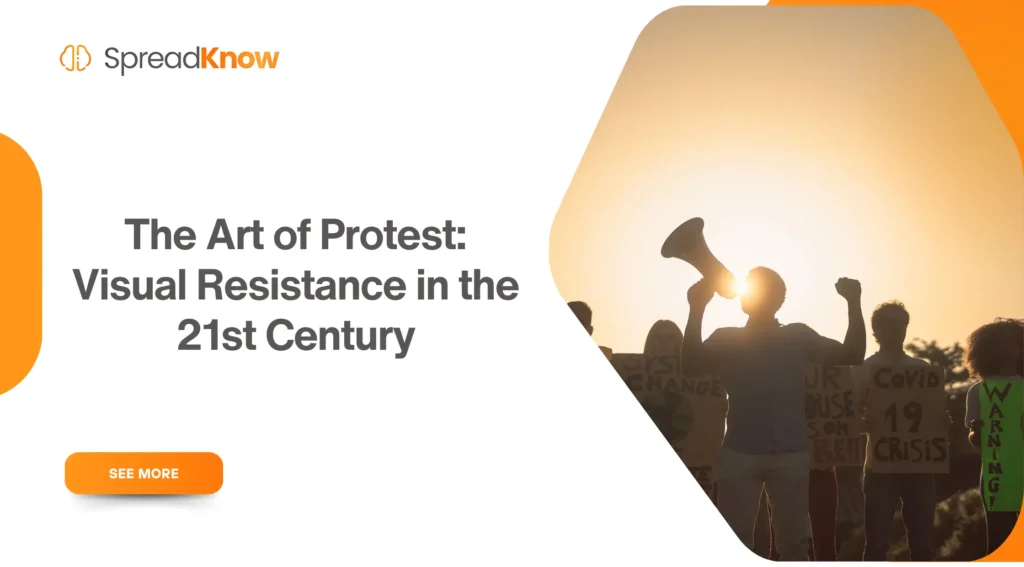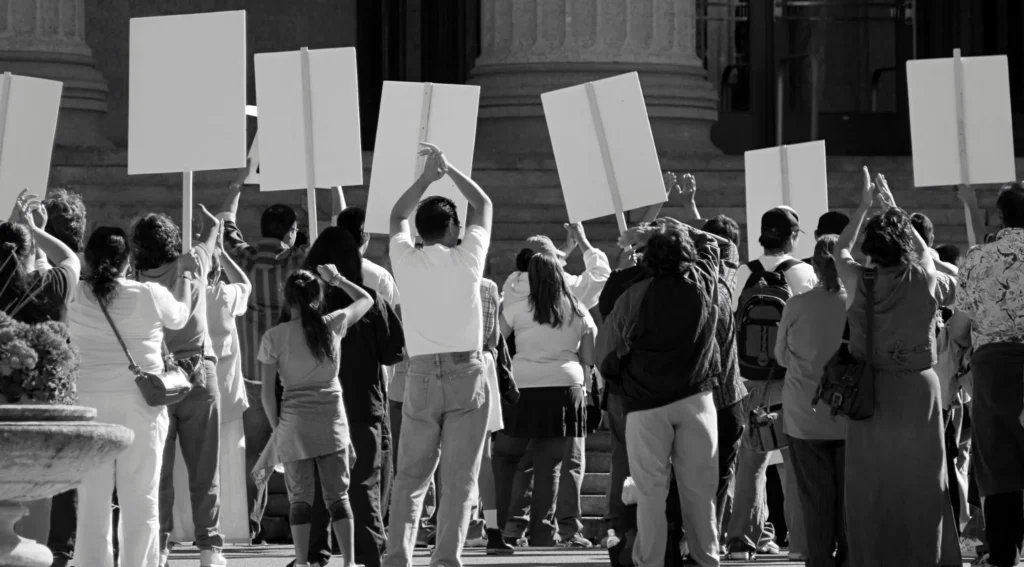The Art of Protest: Visual Resistance in the 21st Century

The Art of Protest has become a defining force in the 21st century, merging creativity with activism to challenge power structures and amplify voices often silenced.
Anúncios
Through murals, posters, digital media, and street art, visual resistance has transcended traditional boundaries, making activism more inclusive and far-reaching.
This contemporary renaissance of protest art is not only a cultural phenomenon but a testament to its enduring power to inspire, mobilize, and effect change.
A Historical Perspective on Protest Art
To understand the Art of Protest, it is essential to look back at its roots.
From Picasso’s Guernica to the bold imagery of the Civil Rights Movement, visual resistance has long served as a mirror reflecting societal struggles.
Anúncios
These artistic expressions transcend languages and borders, evoking universal emotions that foster solidarity.
The 21st century has inherited this legacy, adapting it to an interconnected, digital-first world.
Art has always been a powerful means of storytelling.
During the Vietnam War, for instance, anti-war posters became iconic symbols of resistance, blending vivid imagery with compelling slogans to capture public sentiment.
Similarly, feminist movements in the 1970s leveraged visual art to challenge patriarchal norms, using bold colors and striking compositions to demand equality.
These historical examples illustrate the timelessness of art as a tool for advocacy.
In the digital age, historical protest art is being revisited and reinterpreted.
Contemporary artists often draw inspiration from past movements, reimagining classic works to fit modern contexts.
For example, feminist art from the 70s has been transformed into digital campaigns advocating for reproductive rights, proving that the messages of the past remain relevant and potent.
+ Ceremonial Artifacts: Their Role in Ritual and Identity
The Role of Social Media in Amplifying Visual Protest
Platforms like Instagram, Twitter, and TikTok have revolutionized how protest art reaches the masses.
A single image can go viral within minutes, mobilizing millions worldwide.
During the Black Lives Matter protests in 2020, artwork featuring George Floyd and Breonna Taylor became global symbols of resistance, shared across continents in real time.
Social media also allows for the rapid dissemination of protest art in regions where traditional media is censored.
In countries with restricted press freedoms, platforms like Telegram and Instagram stories have become essential tools for activists.
These platforms offer not only visibility but also safety, as creators can remain anonymous while sharing their work.
Moreover, the digital age allows for greater participation in the Art of Protest.
Tools like Canva and Adobe Spark enable individuals with minimal artistic training to create compelling visuals.
This democratization of art ensures that marginalized voices are no longer excluded from the narrative.
According to a study by Pew Research Center in 2021, over 70% of activists cited social media as a critical tool for spreading their message and recruiting participants.
The accessibility of social media has also birthed new trends in protest art, such as GIFs and memes.
These formats, while seemingly lighthearted, carry deep political messages that resonate with younger audiences.
By leveraging humor and relatability, activists can engage a broader demographic, making their causes more inclusive and far-reaching.
| Platform | Key Features for Activism | Notable Impact |
|---|---|---|
| Visual storytelling, hashtags | Viral protest imagery during BLM protests | |
| Real-time updates, threads | Coordinating global climate strikes | |
| TikTok | Short, engaging videos | Youth-led movements, such as March for Our Lives |
Street Art: The Canvas of Resistance
Street art remains a powerful medium in contemporary activism, transforming public spaces into platforms for dissent.
Banksy, Shepard Fairey, and countless anonymous artists have redefined urban landscapes with works that challenge authority and provoke thought.
These artists blur the lines between vandalism and legitimate expression, forcing society to confront uncomfortable truths.
Murals and graffiti are often situated in high-traffic areas, ensuring maximum visibility for their messages.
For example, the "I Can't Breathe" mural in Minneapolis became a focal point for the George Floyd protests, attracting both locals and international visitors.
Such works not only memorialize victims but also serve as ongoing reminders of systemic injustices.
In Hong Kong, during the pro-democracy protests of 2019, street art played a central role.
Protesters painted slogans like "Liberate Hong Kong" on walls and subways, creating a visual record of their struggle.
Even as authorities tried to erase these messages, the impermanence of the medium symbolized the resilience and adaptability of the movement.
The impermanence of street art is both a challenge and a strength. While works are often removed or defaced, their fleeting nature mirrors the urgency of the issues they address.
Additionally, the temporary nature of these creations encourages continuous artistic innovation, ensuring that the movement’s messages remain fresh and relevant.
| City | Prominent Protest Art Themes | Artist or Movement |
|---|---|---|
| Hong Kong | Democracy, freedom | Anonymous protesters |
| New York City | Police brutality, racial justice | Black Lives Matter murals |
| São Paulo | Corruption, inequality | Pixadores |
++ Learn the Art of Time Management Through Hobbies You’ll Love
The Ethics of Protest Art
While the Art of Protest inspires and unites, it also raises ethical questions.
Who owns public art? Should politically charged images be commercialized?
Shepard Fairey’s Hope poster of Barack Obama exemplifies this tension.
Originally created as a grassroots piece, it became a commercial success, sparking debates about authenticity and commodification.
Another ethical dilemma arises when protest art is appropriated without context.
In some cases, corporations have used imagery from social movements to market products, diluting the original message.
This commercialization risks turning meaningful art into mere aesthetic, stripping it of its power to provoke change.
Additionally, protest art often faces censorship. In authoritarian regimes, creating such work can lead to imprisonment or worse.
Yet, this suppression underscores its importance.
For instance, Ai Weiwei’s installations, often critical of the Chinese government, highlight the risks artists take to speak truth to power.
Censorship also extends to digital platforms.
Algorithms designed to remove "controversial" content often silence activists and artists unintentionally.
This phenomenon, known as shadow banning, disproportionately affects marginalized groups, making it harder for their voices to be heard.
Despite these challenges, protest artists continue to find innovative ways to bypass restrictions and reach their audiences.

The Future of Protest Art
As technology evolves, so too will the tools and mediums of protest art.
Augmented reality (AR) and virtual reality (VR) offer new frontiers for activism.
Imagine donning a VR headset to experience the harrowing realities of a refugee camp or walking through an AR-enhanced gallery of protest art on your smartphone.
These innovations have the potential to deepen empathy and understanding, bridging divides in ways previously unimaginable.
Crowdsourcing platforms are also playing an increasingly significant role in funding protest art projects.
Websites like Kickstarter and GoFundMe allow communities to directly support artists, ensuring that their work remains independent and community-driven.
This grassroots funding model aligns with the democratic ethos of many social movements.
Moreover, NFTs (non-fungible tokens) are emerging as a way to fund activism.
Artists can sell digital works, using the proceeds to support social causes.
This integration of blockchain technology with the Art of Protest ensures that creators retain control over their work while fostering financial sustainability for movements.
As environmental concerns grow, sustainable practices in protest art are gaining traction.
Artists are now creating works using recycled materials or environmentally friendly techniques.
This shift not only aligns with the values of many movements but also sets an example for broader societal change.
Conclusion
The Art of Protest in the 21st century is a dynamic, multifaceted phenomenon that continues to shape and be shaped by the world’s sociopolitical landscape.
From street murals to viral digital art, it leverages creativity to confront injustice, inspire hope, and demand change.
As we move further into a tech-driven era, the power of visual resistance will only grow, proving that art remains one of humanity’s most potent tools for revolution.
